- R.A
- information
- 1057 views
- 0 comments
In this article, we will go to the palace that once witnessed the coronation of the Pahlavi father and son, Ahmad Shah and Muzafaruddin Shah Qajar. At one time, it was a symbol of authority and peace erected by Karim Khan Zand. And another day, it was a humiliating burial place for his bones and a symbol of the victory of Agha Mohammad Khan. In the afternoons, Naser al-Din Shah was smoking hookah on his porch. Only God knows what intrigues and political games he heard in its corridors, which guests its halls hosted, and how its harem changed the course of government.
If you would like to have a royal experience, Golestan Palace is a first-class choice. This article can give you a general picture of walking in the Golestan Palace; Stay with CyrusCrafts team.
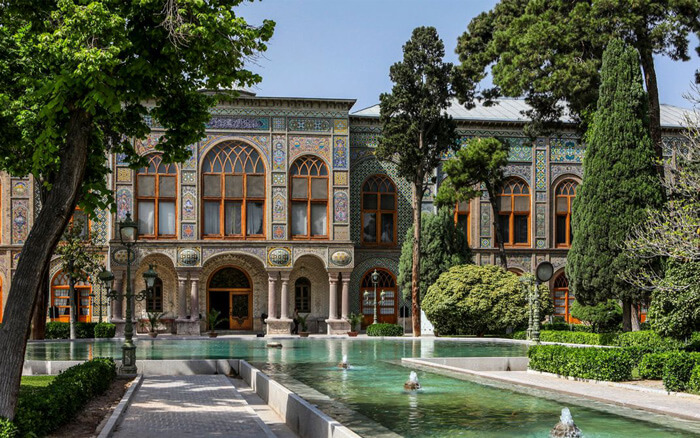
What is the story of Golestan Palace?
Since they have always presented Agha Mohammad Khan Qajar as a violent, ruthless, and bloodthirsty person, Perhaps no one will believe that he was the leading cause of the Golestan palace's present-day glory. The bad news is that the truth has nothing to do with our feelings and mentality. History identifies Agha Mohammad Khan as the prominent architect of this world heritage valuable by UNESCO.
Safavid and Zand dynasty
The story is about this; In 988 AH (1580 BC) and during the reign of Abbas the Great (Abbas 1), a palace was built.
The suitable location, the pleasant climate, and the plane tree that surrounds the building naturally cause the structure to expand and increase in importance.
Forty years later, When the Italian Pietro Della Valle visited it. He gives news of the birth of a royal citadel. The cycle of time turns, and the peace-loving king of the short-lived Zand dynasty comes to power. The fruit of his reign for the palace is an increase in attention to the building and the construction of a courthouse.
Agha Mohammad Khan Qajar
Seventeen years after Karim Khan Zand's death, Agha Mohammad Khan's turn was to become the helm of Iran. Unlike all kings, his choice is not the center of the country, Shiraz and Isfahan, but Tehran.
The new king, in the new capital, needs a place to stay, and what better place than the Golestan Palace, which has been the favorite of his hated and long-time enemy? By order of Agha Mohammad Khan, the bones of Karim Khan are brought from Shiraz to Tehran and buried under the stairs of his daily passage.
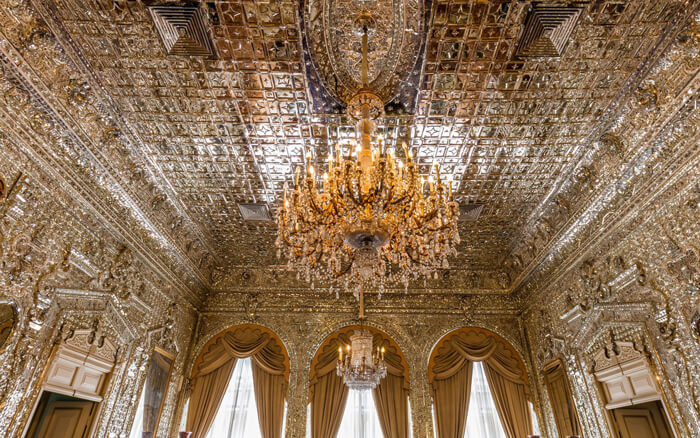
Cyrus Crafts; Luxury & Unique Products
contemporary history of Golestan palace (Tehran)
From here on, the palace's history is tied to the foreign souvenirs of Naser al-Din Shah, Muzaffar al-Din Shah's love of art, the constitutional movement, the escape of Ahmad Shah, and the coronation of the kings of the last dynasty of Iran. To avoid the length of the text, we will skip their detailed description and avoid them in the following words.
What's going on in the Golestan palace now?
If you get to Tehran Bazaar or 15 Khordad Street, finding the Royal Palace won't be challenging. You will come across a beautiful cobblestone, following it leads to an area of almost six hectares and presents the extract of more than four hundred years of history ready.
Remember that what you and we see today is one-tenth of the extent that the Qajar and Pahlavi kings saw. But with these interpretations, it is still possible to visit Golestan Palace one day in the middle of the week and forget about the hustle and bustle of the world in the gold, mirror and tile works, handicrafts, and that elegant tea house at the corner of the garden.
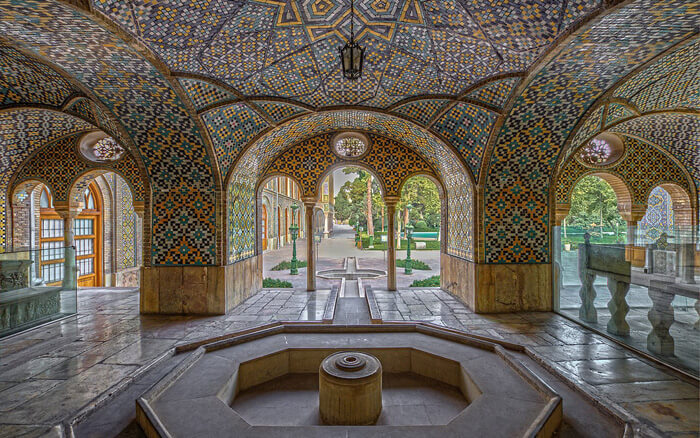
Also, suppose you are in the mood. In that case, it is possible to go to the photography studio and take some historical photos for yourself wearing Qajar clothes.
But the essence of the matter is the area and the buildings that are out of the state of simple architectural works. In a way, they are witnesses of the history of Iran. The change of the course of architecture from the deepest layers of tradition and their integration with the achievements of industrial Europe shows Iran's cultural transition. Especially if you dedicate a whole day to this palace, you will notice the changes.
Buildings and museums in Golestan Palace
The six-hectare area has many palaces, museums, and buildings, each of which reminds us of historical periods. But before we talk about them, we should mention that the Golestan palace's area is filled with trees, ponds, and tiled walls. As a result, if you take pictures or like to feast your eyes on the color and light reflection on the surface of the water, you can find out the progress of the buildings and the grounds of the palace.
Edifice of the Sun (Shams ol Emareh) of Golestan palace
It is unknown how the idea of having a vast and high-rise building first came to Naser al-Din Shah Qajar. Maybe viewing Farang's pictures and maybe the desire to observe the territory under the command from a height; Whatever it was; In 1282 AH (1865 BC), he commissioned Muir al-Mamalek to build a five-floors building on the eastern side of the citadel.
The King's dream became a reality only two years later, i.e. in 1284 AH (1867 BC). From an engineering point of view, Shams ol Emareh is one of the first buildings in Iran, which was erected with an iron frame and has advanced up to 35 meters in the sky.
From the point of view of architecture and art, mirror work, plastering, tile work, and the spirit of Iranian structure have been breathed into the heart of a western structure to create a special and unique concoction of tradition and modernity.
At the end of the day, after leaving the Golestan Palace, see how much it costs to visit the Shahan Palace. Meanwhile, keep in mind that the construction and equipping of the Edifice of the Sun (Shams ol Emareh) have been completed with a budget of 40 thousand tomans (around 2 dollars these days).
Marble Throne (Takht e Marmar) of Golestan palace
If you have seen the pictures of Reza Shah's coronation, maybe you remember the marble throne, which is placed on the shoulders of demons and fairies. The king sits on it, just like in the ancient stories. This throne is located on the marble porch and tells a long history. Karim Khan built the porch, and during special ceremonies, it enabled people to attend the palace and meet the king.
When Agha Mohammad Khan came to power, He ordered to collect the artworks of the Vakil palace and brought them from Shiraz to Tehran. And he made a new color and fragrance to the simple porch of Karim Khan with columns, marble, paintings, and mirrors.
Fath-Ali Shah Qajar also leaves the last memory; A throne made of yellow marble evokes the throne of Suleiman. And it has left no room for words and hadiths in its beauty.
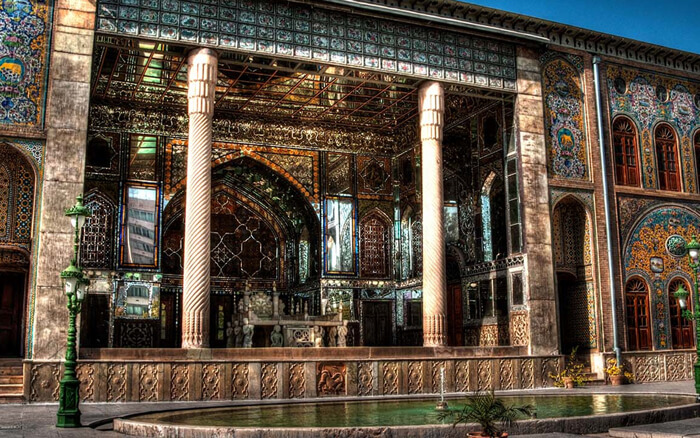
Karim Khani Nook (Khalvat e Karim Khani)
Karim Khani Nook (Khalvat e Karim Khani) is one of the most famous buildings of Golestan Palace. This place is right next to the balcony of the Marble Throne (Takht e Marmar) and stands out in front of the palace's main entrance with three openings and a basin in the middle.
Don't look at the silence and stillness of the pond today. At one time, the roaring water of the aqueduct was in its heart and watered all the trees in the area.
Let's pass. The story of Karim Khani Nook and the four kings is like this.
- Karim Khan used to spend time in it.
- Agha Mohammad Khan brought his rotting bones from Shiraz to its steps daily by passing over them. And he avenged his harsh childhood on the remaining Karim Khan (the king of the Zand dynasty).
- Naser al-Din Shah Qajar used to get fat in that hookah.
- Reza Shah again removes the famous bones from under the stairs to show the Qajar dynasty that the hand is above the hand.
Now, this possibility is available for you and me to go to the palace and see the mentioned process from a distance.
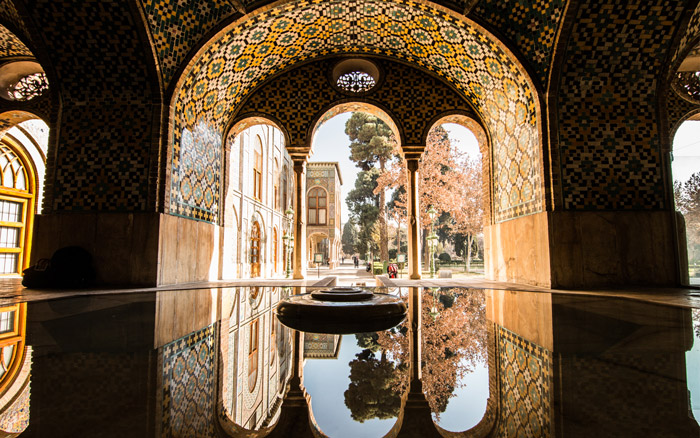
Building of Windcatchers (Emarat e Badgir)
Suppose you like to put your eyes before pure beauty. In that case, You should look for the Building of the Windcatchers (Emarat e Badgir) of the Golestan Palace. The floor, ceiling, wall, window, light, column, and whatever you can think of are decorated in the most aristocratic way and with hand art.
Another importance of this building is that, in a way, the beginning of new Iran parallels the birth of this building. Strictly speaking, almost every other building in the palace has a pre-Qajar history. However, the building of Windcatchers started with the accession of Fath-Ali Shah. It was completed with a small renovation during the Naser al-Din Shah period.
Today use of the basement of the Emarat e Badgir is a photographer's studio. While in before, it was called a pond. In this way, if the king is not in the villa, the summers are spent in the coolness of the wind, guided by the wind and cooled by the pond's water.
Photographic archive
When Nasir al-Din Shah visited Farang for the first time, he fell in love with the country's art style, museums and galleries. For this reason, by building a gallery, he created a suitable platform for hanging artists' works. In the second Pahlavi period, Naser al-Din Shah added the gallery area, and artworks before and after the Qajar period can be seen in this museum.
Main halls of Golestan Palace
Now we come to the main attractions of the palace or the main halls that play the soul and soul of every Delhi person. This collection of halls was built in the northeast of the Golestan palace, and each has its unique personality, like a living being.
Salam Hall (Talar e Salam) of Golestan palace
Hall of Salam is located upstream of Karim Khani Nook and is the product of Naser al-Din Shah's lust and jealousy for the vast and magnificent western structures. He destroys the old buildings in the garden. He builds the Hall of Salam for himself, imitating the museums of Farangi.
It's not bad to know that after the completion of Salam Hall, three years of the king's time were spent directly supervising its decoration and arrangement. And there was no time for statecraft. Of course, the other side of the coin is that today we can clearly recognize a king's taste in decoration.
Mirror Hall (Talar e Aineh) of Golestan palace
At the same time as Salam Hall and on the west side of it, a hall named Aineh (Mirror) was running. At the beginning of the work, the task of maintaining the throne and crown was assigned to this hall, but Kamal al-Molk came to, and a first-class painting made it world famous.
Other halls of the Golestan palace
Halls Ivory (Talar e Adj), Containers (Talar e Zoruf), and Brilliant (Talar e Brelian) are other buildings of the Golestan Palace. Servings from the Russian Emperor, Queen Victoria, Alexander III, and Wilhelm are waiting for you to visit, along with a wealth of paintings, plasterwork, and mirrors.
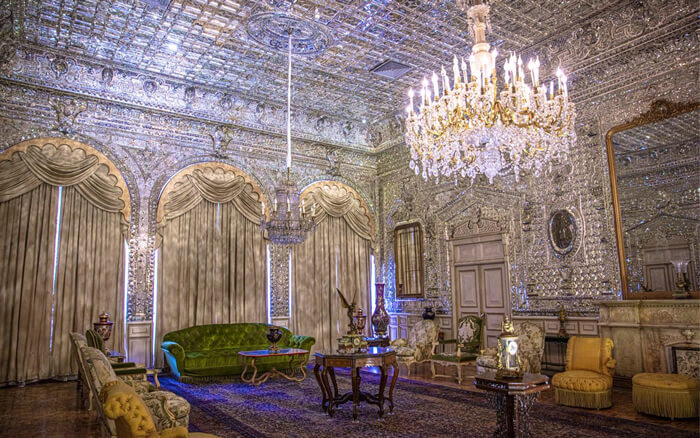
CyrusCrafts' last word about Golestan palace
This article in CyrusCrafts magazine briefly discussed the Golestan Palace and reviewed its most important attractions. The gilding on the stone, delicate mirror works, extraordinary tile works, and the combination of western and eastern architecture are mentioned. And most importantly, the four hundred years of the history of the kingdom of this land is not something that can be presented in a unified way in another collection.








Comments (0)